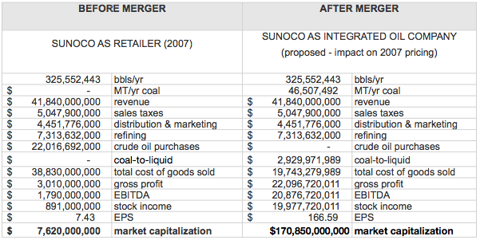Page added on September 23, 2012
Energy After The Peak: Merger Of Coal And Refiners Replaces Conventional Oil
The chart above shows the number of refineries and their output in North America over time. Its clear following the 1970 oil shock that major integrated oil companies have not invested in refineries. This gave rise to the independent refiners as an important resource in the US. Over half of the refining capacity is now owned by independent refineries. The two largest are;
- Valero Energy Corp. (VLO): Valero is the largest independent refining company in North America and has a capacity of 3.3 million barrels per day.
- Sunoco Inc. (SUN): The second largest independent, Sunoco refines 990,000 barrels of crude a day.
Performance of these refinery stocks may be due for a powerful comeback! To understand how this might occur, let’s look at some recent history and the long term trend in the oil business and how these stocks and others like them might benefit from these changes.
Major oil companies have for 40 years now under-invested in refineries, creating an artificial scarcity in oil. Some experts observe, if you do not have crude to run through them, why invest in new refineries?
But is that received wisdom true? While it is certainly true that the logistic curve computed for conventional oil production in 1954 is accurate, it is not true that conventional oil is the only energy supply available in sufficient abundance at a competitive cost.
We have known since 1911 that hydrogen may be added to coal to produce petroleum products. Frederich Bergius received a Nobel Prize in 1931 for this achievement. Following World War II Truman backed the production of a 200,000 barrel per day coal liquefaction plant based on Bergius’ process. IG Farben ceded the technology to the UN as part of War Reparations for Germany.
BP (BP) acquired the technology and canvassed the White House to close the Missouri plant. Truman kept it open. The plant sold oil that was competitive in quality and cost with conventional oil. BP persisted and eventually Eisenhower created an energy committee which recommended closure of the plant.
When South Africa passed their apartheid policies in 1948, and expanded them in 1950, Saudi Arabia refused to sell oil to that country. As a result, South Africans began developing their coal reserves. BP denied them the use of the Bergius direct hydrogenation process, so South Africa used the inferior Fischer-Tropsch process.
Until the Shenhua coal company began construction of a Bergius direct hydrognation reactor, most investors thought wrongly that Fischer-Tropsch was the only way to produce coal and that the liquids produced were the best that could be done. Despite the excellent work of Bergius in 1911, the US has supported billions of dollars in coal research, research that ignores Bergius and finds, surprisingly, the need for more research going forward.
The numbers for Bergius are, one metric ton of coal is converted into 6.2 barrels of liquid fuels with the application of 125 kilograms of hydrogen gas. This hydrogen gas may be produced by carrying out a shift reaction with another 375 kilograms of coal and 1,125 liters of water. It may also be produced by a high temperature nuclear reactor by direct thermolysis as suggested by Brookhaven Labs and Westinghouse in 1961. This in response to a request from JFK to find a solution to the problem of oil shortages before the crisis hit. BNL felt that with a dedicated effort, we could have oil at competitive rates of $2 per barrel by 1968 and by 1988 transition to an all hydrogen economy where energy costs were $0.20 per barrel equivalent. Many rosy scenarios were built around an industrial economy with energy that abundant at that price. Now, that’s leadership!
The report languished on the desk of president Johnson after November 1963 and was eventually forgotten. It was resurrected by Jimmy Carter, a former US Navy nuclear engineer. Unfortunately, the very month Carter submitted his revised plan to Congress three things happened that galvanized the nation. The family of Karen Silkwood received a $5 million wrongful death settlement against Kerr-McGee. Ms. Silkwood processed plutonium pellets at Kerr-McGee’s Cimmarron fuel processing site.
This got the nation asking the question, just how safe is nuclear power? As the media began grinding out this question to a concerned nation, after thirty years of safe nuclear power, as far as most Americans were concerned at the time, Three Mile Island melted down and released radioactive waste despite assurances previously that this could never happen. Then, finally, as a coup de grace, the hit movie China Syndrome, with Jane Fonda, was released to rave reviews.
At the end of this unfortunate sequence of events the result on capitol hill was predictable, the nation will spend any amount of money needed to address the energy issues facing it, it will not consider any solution based on nuclear energy. Over the next decade America spent more money on energy research than it spent going to the moon. The result? More research is needed. Bergius was ignored. That’s old technology.
Old technology or not, the total cost of producing oil today with Bergius is $8.57 per barrel. At today’s prices, this produces a gross profit in excess of $100 per barrel! The US consumes 6.8 billion barrels of oil per year. If we made 6.8 billion barrels from domestic coal we would add over $10 billion per week to our economy. This cash flow may be hypothecated to cover all external debt, and bring sanity back to our economy. We might even consider an oil backed dollar in this case.
How might these independent refineries benefit from Bergius’ technology? Well, they could convert themselves to domestically sourced integrated oil companies using US coal to make petrol. This could be achieved by merging with an appropriately sized coal mine. Such an announcement would precede a dramatic increase in value of both companies.
The impact of such a merger would be large.
Consider Westmoreland Coal Company (WLB). It has coal reserves of 389.9 million tons of coal and a market cap of $162.94 million, producing $0.42 of value for each ton of reserves.
Now, consider Sunoco, Inc., it has no oil reserves and retails 990,000 barrels of oil per day. As a result, it has a market cap of $4.15 billion and sales of $44.61 billion.
Look what happens when we merge these two companies and build a $5.54 billion Bergius reactor to make SUN oil from WLB coal: First, the SEC allows us to value WLB’s coal as 2.4 billion barrels of oil at nearly $14 billion – providing tremendous returns straight-away. Next, SUN cost of sales plummet and profits skyrocket, increasing market cap to over $170 billion!
Obviously, with increased valuation, the company is in a strong position to expand. Other independents will also be inspired to compete. Eventually all of America’s 279 billion tons of coal will be valued as 1.8 trillion barrels of notional oil production in the future. This is more than twice the oil left in the world today from conventional sources. A reserve of oil that is worth well over $8.8 trillion in the ground.
This vast and rising value forms the basis for further productive expansion of the US’ industrial economy for another generation.
3 Comments on "Energy After The Peak: Merger Of Coal And Refiners Replaces Conventional Oil"




BillT on Sun, 23rd Sep 2012 4:08 pm
“… This vast and rising value forms the basis for further productive expansion of the US industrial economy for another generation…”
This last sentence is a joke. The US industrial economy is, and has been, shrinking for the last 30 years. There is no future growth, just decline in the Empire’s future.
DC on Sun, 23rd Sep 2012 5:27 pm
Only vaguely on-topic. Another add pushing ‘stocks’. But the stock pimps are funny arent they? He talks about a slightly different method of CTL. And then goes on to say using H2 gas(an expensive derived element), or even better! using a *nuclear* reactor to ‘help’ the process along! And then has the nerve to call it ‘cheap’. I guess the cost of deriving H2, or building nuclear reactors must be close to zero over@ S.A. One metric ton of coal for 6 barrels! Not cheap! Everything in that ‘Bergius’ process screams Net energy loser..
There is a reason why CTL isnt used. Its complex, dirty and expensive, no matter what ‘method’ you use. In 1930 the world was still flush with coal, and it was dirt cheap, and it STILL didnt catch on.
Nuff said…
Kenz300 on Mon, 24th Sep 2012 4:06 pm
Oil and coal companies have been flooding the TV and radio with commercials touting their benefits to the economy. They want to keep their semi-monopolies going as long as they can without any real competition from alternatives. Wind, solar, wave energy and geothermal energy production is rising around the world. The transition to alternative energy sources has begun and is growing every year.